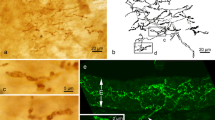Summary
Immunohistochemistry was used to investigate the distribution pattern of calcitonin gene-related peptide (CGRP) nerve fibers in the laryngeal mucosa, glands and intrinsic muscles of the dog. CGRP immunoreactive nerve fibers were found more frequently than substance P immunoreative nerve fibers in every region of the larynx. In the epithelia, CGRP nerve fibers were mainly found in the epiglottis, arytenoid region and subglottis. Many taste buds were observed in the arytenoid region and were densely innervated by the CGRP nerve fibers. In the lamina propria, the plexus of CGRP nerve fibers was present, with some of these fibers associated with blood vessels. Laryngeal glands were also innervated by a few CGRP nerve fibers. In the intrinsic laryngeal muscles, abundant immunoreactivity was observed and many motor end-plate-like structures were found with CGRP immunoreactivity. These findings strongly suggest that CGRP plays an important role in all of the sensory, motor and autonomic nervous systems of the larynx.
Similar content being viewed by others
References
Gibson SJ, Polak JM, Bloom SR et al. (1984) Calcitonin generelated peptide immunoreactivity in the spinal cord of man and eight of other species. J Neurosci 4:3101–3111
Gulbenkian S, Merighi A, Wharton J, Varndell IM, Polak JM (1986) Ultrastructural evidence for the coexistence of calcitonin gene-related peptide and substance P in secretory vesicles of peripheral nerves in the guinea pig. J Neurocytol 15:535–542
Hanko J, Hardebo JE, Kahrstrom J, Owman C, Sundler F (1985) Calcitonin gene-related peptide is present in mammalian cerebrovascular nerve fibers and dilates pial and peripheral arteries. Neurosci Lett 57: 91–95
Hisa Y (1982) Fluorescence histochemical studies on the noradrenergic innervation of the canine larynx. Acta Anat (Basel) 113:15–25
Hisa Y, Matsui T, Fukui K, Ibata Y, Mizukoshi O (1982) Ultrastructural and fluorescence histochemical studies on the sympathetic innervation of the canine laryngeal glands. Acta Otolaryngol (Stockh) 93:119–122
Hisa Y, Sato F, Fukui K, Ibata Y, Mizukoshi O (1985) Substance P nerve fibers in the canine larynx by PAP immunohistochemistry. Acta Otolaryngol (Stockh) 100:128–133
Kirchner JA, Suzuki M (1968) Laryngeal reflexes and voice production. Ann NY Acad Sci 155:98–109
Koizumi H (1953) On the sensory innervation of the larynx in the dog. Tohoku J Exp Med 58:199–210
McWilliam PN, Magbool A, Batten TFC (1989) Distribution of calcitonin gene-related peptide-like immunoreactivity in the nucleus ambiguus of the cat. J Comp Neurol 282:206–214
Morishima Y, Takagi H, Kawai Y, Emson PC, Hillyard CJ, Girgis SI, MacIntire I (1986) Ultrastructural observation of nerve fibers containing both substance P and calcitonin generelated peptide in the nucleus tractus solitarii of the rat: a combination of immunofluorescence and PAP methods. Brain Res 379:157–161
Nakano T, Muto H (1987) Anatomical observations in the arytenoid region of the mouse with special reference to the function of the taste buds. Z Mikrosk Anat Forsch 101:205–211
New HV, Mudge AW (1986) Calcitonin gene-related peptide regulates muscle acetylcholine receptor synthesis. Nature 323:809–811
Palmieri GA, Asole A, Panu R, Sanna L, Farina V (1983) On the presence. structure and probable function role of taste buds located on the laryngeal surface of the epiglottis in some domestic animals. Arch Anat Histol Embryol 66:55–66
Rosenfeld MG, Mermord J-J, Amara SG et al. (1983) Production of a novel neuropeptide enclosed by the calcitonin gene via tissue-specific RNA processing. Nature 304:129–135
Silverman JD, Kruger L (1989) Calcitonin gene-related peptide immunoreactive innervation of the rat head with emphasis on specialized sensory structures. J Comp Neurol 280:303–330
Suzuki M, Kirchner JA (1967) Larnygeal reflex pathways related to rate and rhythm of the heart. Ann Otol Rhinol Laryngol 76:774–780
Takami K, Kawai Y, Uchida S, Tohyama M, Shiotani Y, Yoshida H, Emson PC, Girgis S, Hillyard CJ, MacIntire I (1985) Effect of calcitonin gene-related peptide on contraction of striated muscles in the mouse. Neurosci Lett 60:227–230
Terenghi G, Polak JM, Rodrigo J, Mulderry PK, Bloom SR (1986) Calcitonin gene-related immunoreactive nerves in the tongue, epiglottis and pharynx of the rat: occurence, distribution and origin. Brain Res 365:1–14
Widdicombe J (1973) Supplementary statement II. In: Wyke BD (ed) Ventilatory and phonatory control systems. Oxford University Press, London, pp 465–468
Wyke BD, Kirchner JA (1976) Neurology of the larynx. In: Hinchcliffe R, Harrison D (eds) Scientific foundation of otolaryngology. Heinemann, London, pp 546–574
Author information
Authors and Affiliations
Rights and permissions
About this article
Cite this article
Hisa, Y., Uno, T., Tadaki, N. et al. Distribution of calcitonin gene-related peptide nerve fibers in the canine larynx. Eur Arch Otorhinolaryngol 249, 52–55 (1992). https://doi.org/10.1007/BF00175672
Received:
Accepted:
Issue Date:
DOI: https://doi.org/10.1007/BF00175672



